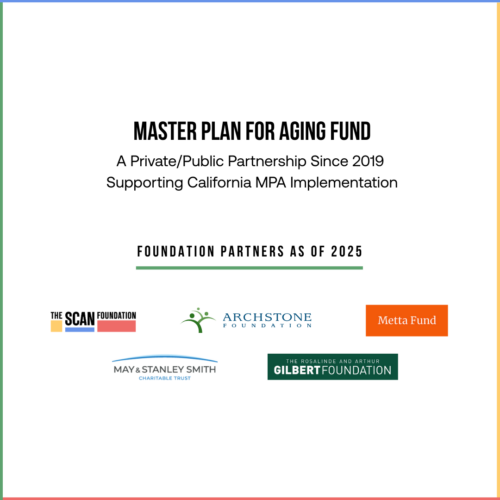The SCAN Foundation (TSF) advocates for Multisector Plans for Aging (MPAs) as a means to centralize these considerations, providing a roadmap and accountability framework for reforms. MPAs offer a 10-year blueprint to restructure policy and programs across various sectors, including health, housing, transportation, and more. In California, this plan is referred to as a “Master” Plan for Aging. We use MPA interchangeably throughout this website.
Building off California’s success in 2020, over half of all states have initiated an MPA. In addition, implementation of MPAs is occurring on a local level. Finally, at a national level the Interagency Coordinating Committee on Healthy Aging and Age-Friendly Communities (ICC) has been charged with developing a coordinated approach to addressing key areas related to healthy aging and age-friendly communities, through the Strategic Framework on Aging.

Focus on: California’s Master Plan for Aging
In June 2019, California Governor Gavin Newsom issued an executive order calling for a state MPA. After an extensive planning process, California’s plan was released in January 2021. This historic effort delivered a comprehensive roadmap for system-wide change in how services are coordinated, delivered, and financed better to meet the needs of our state’s aging population.
This 10-year multisector plan strategically enhances aging services and care, prioritizing equity by centering the diverse experiences of older Californians. Progress is monitored through the MPA Implementation Tracker, Data Dashboard for Aging, and annual progress reports.
Read California’s latest annual report to learn how the MPA is benefiting older adults, people with disabilities, caregivers, and families.

Rural MPA Toolkit
To help elevate the unique needs of rural communities, TSF supported the development of local MPAs in rural regions of California. We partnered with the Family Caregiving Institute at the University of California Davis to create a Toolkit for Developing Local Multisector Plans for Aging in Rural Areas, a step-by-step guide to creating rural MPAs built from lessons learned. The resource is packed with adaptable steps and tools to help rural leaders create age-friendly, equitable communities for older adults.
To learn more and view the toolkit, visit the rural MPA webpage.
Building the Case for California MPA
The SCAN Foundation was instrumental in building the case for the California MPA by supporting polling efforts to influence political will and convening stakeholders to shape MPA development. Voter polling (e.g., May 2021’s poll) and media coverage helped demonstrate public support to executive (state) and legislative leaders.
Advocacy Via Committee Participation
TSF continues to influence MPA implementation through its participation in the Implementing the MPA in California Together (IMPACT) Committee, the Disability & Aging Community Living Advisory Committee, and the California Aging and Disability Research Partnership Committee.

MPA Fund: A Vital Partnership
Since 2019, The SCAN Foundation (TSF) and its philanthropic partners have supported California MPA development and implementations through an MPA Fund, leveraging funds for research and technical assistance to build capacity and propel initiatives forward.
Over the years, partners included Archstone Foundation, Gary and Mary West Foundation, Irvine Health Foundation, May & Stanley Smith Charitable Trust, Metta Fund, The San Diego Foundation, The Rosalinde and Arthur Gilbert Foundation, and The SCAN Foundation.
MPA in Other States
As the older adult population diversifies, there’s a crucial opportunity to shape state policies that better reflect the needs of historically marginalized groups. State leaders are driving cross-sector planning efforts to address the needs of older adults, people with disabilities, and family caregivers through multisector plans for aging (MPAs).
The Multisector Plan for Aging Learning Collaborative, facilitated by the Center for Health Care Strategies (CHCS) and supported by The SCAN Foundation, West Health, and the May & Stanley Smith Charitable Trust, is currently aiding 27 states to advance their MPAs. Since its launch in 2022, this collaborative has engaged state teams nationwide in this cross-sector learning endeavor.
To support state success and foster shared learning, the collaborative is providing:
- Peer-to-peer exchange that fosters the sharing of best practices and lessons
- Access to a network of experts, including those who have helped advance MPAs in other states
- Technical assistance on how to build cross-sector buy-in and facilitate a collaborative MPA development process
Advancing Multisector Plans for Aging
MPAs ensure that services are integrated and coordinated and support everyone to age with health, dignity, and connection. The Center for Healthcare Strategies has created and curated a set of resources to support states in the development and implementation of MPAs.
LINKS: “Getting Started” tool and the involving family caregivers tool are on the MPA project page.